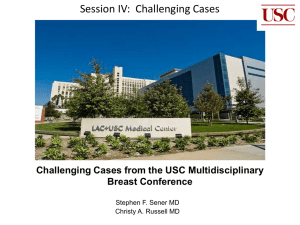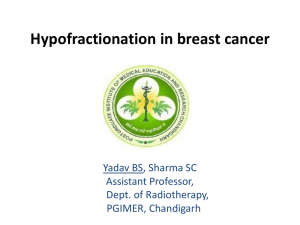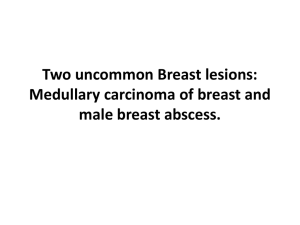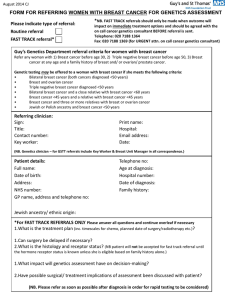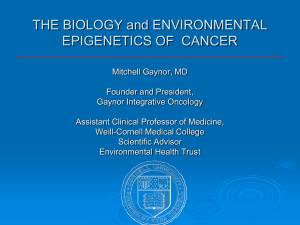Slides - WSMOS
advertisement
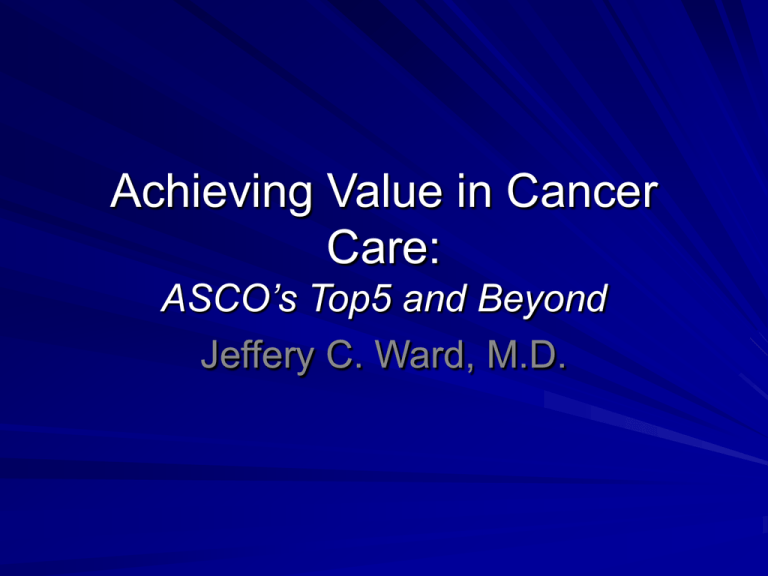
Achieving Value in Cancer Care: ASCO’s Top5 and Beyond Jeffery C. Ward, M.D. ASC0 2012 Top 5 Presentation Thomas J. Smith, MD Medical Oncologist Sidney Kimmel Comprehensive Cancer Center Baltimore, MD Douglas W. Blayney, MD Derek Raghavan, MD, PhD, FACP Professor of Medicine, Medical Oncologist Stanford President Levine University School Cancer Institute of Medicine Charlotte, NC Ann & John Doerr Medical Director, Stanford University Cancer Center Stanford, CA Patricia A. Ganz, MD Therese M. Mulvey, MD Professor, UCLA Schools of Medicine & Public Health Division of Cancer Prevention and Control Research Jonsson Comprehensive Cancer Center Los Angeles, CA Medical Oncologist Southcoast Center for Cancer Care Fall River, MA ASCO’s Top 5 List For patients with advanced solid-tumor cancers who are unlikely to benefit, do not provide unnecessary anticancer therapy, such as chemotherapy, but instead focus on symptom relief and palliative care. Do not use PET, CT and radionuclide bone scans in the staging of early prostate cancer at low risk for metastasis. Do not use PET, CT and radionuclide bone scans in the staging of early breast cancer at low risk for metastasis. For individuals who have completed curative breast cancer treatment and have no physical symptoms of cancer recurrence, routine blood tests for biomarkers and advanced imaging tests should not be used to screen for cancer recurrences. Avoid administering colony stimulating factors (CSFs) to patients undergoing chemotherapy who have less than a 20 percent risk for febrile neutropenia Do Not Routinely Give Chemotherapy to Patients with Poor Performance Status (PS), ECOG 3 or 4 Patients with poor PS have more toxicity and markedly less chance of response. Not every cancer, but for most patients with solid tumors, ASCO and National Comprehensive Cancer Network (NCCN) guidelines call for a switch to palliative (non-chemotherapy) care when the ECOG PS ≥ 3. - ECOG 3 is “in bed or chair more than 50% of the time.” - Simple question: “Did this person walk unaided into clinic?” Do Not Routinely Give Chemotherapy to Patients with Poor Performance Status (PS), ECOG 3 or 4 Exceptions - patients with functional limitations caused by other conditions - that result in a low performance status (PS) or those with disease characteristics (e.g., mutations) that suggest a high likelihood of response to therapy. Changing the focus to symptom control should be accompanied by appropriate palliative and hospice care. Do Not Routinely Give Chemotherapy to Patients with Poor Performance Status (PS), ECOG 3 or 4 This is disease specific ‒ With breast cancer, eribulin improved overall survival from 10.6 to 13.1 months compared to alternative 4th line treatments. ‒ But with NSCLC the chance of response is small, only 2% with 3rd line, and 0% with 4th line chemotherapy, with no OS benefit. In general for patients with solid tumors nth line chemotherapy will be toxic, rarely helpful, expensive, and avoid planning for transitions to hospice. Do Not Routinely Give Chemotherapy to Patients with Poor Performance Status (PS), ECOG 3 or 4 The NCCN and ACSO NSCLC guidelines recommend nonchemotherapy based palliative care if the PS is ≥ 3. The NCCN breast cancer guidelines suggest no further cytotoxic therapy and transition to palliative care when the cancer has had no response to 3 sequential regimens. ASCO has always recommended that treatment not be given unless there is a definable benefit. Solutions: Documentation, and Use QOPI Always document ECOG PS. Use QOPI to monitor practice patterns about chemotherapy near the end of life. When oncologists were given feedback about their own practice patterns, chemotherapy near the end of life dropped from 50% to 20%. Blayney D, et al. JCO 2009 Conclusions Patients with poor performance status or resistant disease rarely benefit from chemotherapy near the end of life, and do suffer toxicity. Routinely measure the # of “lines” of treatment and response, and the ECOG PS. Have a hospice information visit earlier in the disease course, with 3 to 6 months to live, to include hospice as an ASCO-recommended best practice and to make the transition easier. Don’t Perform PET, CT and Bone Scan in Breast Cancer Patients at Low Risk for Metastases Key to determining studies is the careful history and physical examination. Probe for symptoms suggesting metastases. Probe for signs of locally advanced breast cancer. Decision for imaging studies outside guidelines or clinical trial should be carefully reviewed with the patient, and based on her symptoms and her physical findings. Non-indicated scans can lead to unnecessary anxiety, testing and morbidity. In the era of effective adjuvant therapy, micro metastases are likely to be effectively treated. Conclusions No evidence of survival improvement. No benefit in asymptomatic individuals with newly identified ductal carcinoma in situ (DCIS), or clinical stage I or II breast cancer. Can lead to harm through - Unnecessary invasive procedure over-treatment, unnecessary radiation exposure, and misdiagnosis. Features of Localized Prostate Cancer Most cases at low risk of metastasis: ‒ Bone ‒ Nodes More than 50% of men older than 65 years of age have clinically silent presence of prostate cancer – it doesn’t harm most of these men. Many cases of prostate cancer deteriorate slowly or not at all. There are predictors of rapid growth and spread of prostate cancer, which physicians use to help plan the approach to testing and treatment. Definition of Low-risk Prostate Cancer Criteria that Correlate with Negative Staging Tests: Absence of Symptoms T1 tumors (status of T2 tumors?) PSA < 10 ng/ml at presentation Gleason’s Score of ≤ 6 Experience with Unnecessary Staging Tests for Prostate Cancer Palvolgyi, et al. (2011) Choi, et al. (2011) 1,598 men studied 6,444 men studied 519 with low-risk CAP had bone scans PSA < 10 ng/ml CS T1-T2 Gleason score < 7 2,330 (36%) had multiple scans 132 underwent bone scans 0 positive Palvolgyi et al. Urology 2011; 77:1330-1336 Choi et al. J. Urol., 2011, 185: 1645-1649 Only 1% positive Consistent with international results NO consistent pattern of test – geographic variation Increase with social/economical status Income Greater high school education Experience with Unnecessary Staging Tests for Prostate Cancer Lavery et al. (2011) 677 men with low risk CAP 48% had 1 study 30% had 2 studies 3% had 3 studies 349 had no imaging 96% of CT scans were negative (0 positive at surgery) Institutional Charges: CT a/p: $1,480 Bone scan: $512 MRI: $2,500 Medicare Reimburse: CT a/p: $976.98 Bone scan: $299.01 MRI: $823.32 0 changes in clinical management from scans 328 patients Imaging: $644,392 Surgery: $654,507 Lavery et al. Urology, 2011, 77: 274-279. Conclusions Low-risk early-stage prostate cancer, defined by PSA < 10 ng/ml and Gleason’s score < 6, has a low risk of metastasis. Staging tests do not improve outcomes of treatment for this clinical problem. Extensive staging is: – Unnecessary – Expensive – Exposes patients to unnecessary radiation. Surveillance Testing after Curative Treatment of Breast Cancer Serum Tumor Markers and Imaging What is the role of a surveillance test in cancer follow-up, and when does it ad value for patient outcomes or mortality? What do we know about surveillance in breast cancer patients treatment with curative intent? What follow-up strategies are recommended for this patient population? What Do We Know About Surveillance Testing after Breast Cancer Data from clinical trials, conducted in the 1980’s and 1990’s demonstrated that routine monitoring with chest films, radionuclide liver and bone scans did detect a recurrence earlier than clinical evaluation, and was abandoned as part of routine follow-up. Two randomized trials conducted in the 1990’s did not find a difference in survival outcomes for women who had routine clinical office visits and mammograms compared to women who had more intensive monitoring with blood work, chest films, scans and ultrasounds. ASCO Guideline 2006 Rojas et al. Cochrane Review 2005 What Do we Know About Surveillance Testing after Breast Cancer Tumor markers used in breast cancer monitoring (CEA, CA 15-3, CA 27.29) have not been shown in randomized trials to effect survival outcome, i.e. that detection of recurrence earlier makes a difference. The rate of false negative or false positive findings for these markers is not known. Normal or abnormal tumor marker results can contribute to false reassurance or increased anxiety for patients, as well as unnecessary medical evaluations. What about Imaging Tests? Chest and abdominal CT scans or whole-body PET scans have not been evaluated as surveillance strategies for follow-up of early-stage breast cancer. With the low prevalence of distant recurrence in earlystage breast cancer, and the high risk of false positive and incidental findings, there is no evidence to support the use of routing imaging tests. What Should I Advise My Patient Who Has Had Curative Treatment for Breast Cancer Report any new or persistent symptoms (e.g. cough, pain, new lumps, dyspnea) for medical evaluation. Have regular oncology follow-up visits every 3-6 months in the first three years; every 6 months for the next 2 years. Have annual follow-ups after 5 years that can be continued with a primary care provider, ensuring that a breast examination and mammogram are done annually. Don’t have routine blood work for breast cancer monitoring after initial treatments. Have bone density monitoring and lipid measurements if aromatase inhibitor therapy is taken. Conclusions Don’t perform surveillance testing (biomarkers) or imaging (PET, CT and radionuclide bone scans) for asymptomatic individuals who have been treated for breast cancer with curative intent. Do perform regular interval history and physical examinations, including clinical breast examination, and schedule annual breast mammograms. Do promptly evaluate any clinical symptoms that are suspicious for a recurrence, using blood work, tumor markers and imaging as appropriate. Eliminate the Use of White Cell Stimulating Factors in Patients Who Are Not at High Risk for this Complication Febrile Neutropenia (FN) is a life threatening emergency. ‒Increased cost associated with treatment of febrile neutropenia. ‒Morbidity can be significant. ‒Mortality ranges from 10%-90% depending on associated comorbidities. Granulocyte Colony Stimulating Factors (G-CSFs) reduce the duration and severity of febrile neutropenia. ‒Increased cost with use of these agents. ‒Decreased morbidity and mortality with use of G-CSFs. What is appropriate use? Guidelines 2006 ASCO Guideline: Use Granulocyte Colony Stimulating Factors (G-CSFs) when the risk of febrile neutropenia is greater than 20%. “In some situations, primary prophylaxis with CSFs is essential and recommended to alleviate the toxicity of certain ‘dose dense’ chemotherapy regimens”. Factors that increase risk of FN greater than 20% Age greater than 65 Poor performance status Prior episodes of FN Prior chemotherapy or radiation Poor nutritional status Other comorbidities Risk Stratification High risk of FN – greater than 20% risk Most non-Hodgkin Lymphoma regimens Dose dense AC-T Intermediate risk of FN – 10%-20% Most doublets for adjuvant lung cancer Low risk of FN – less than 10% Most palliative single agents for solid tumors Conclusions Granulocyte Colony Stimulating Factors (G-CSFs) are essential to deliver correct dose and schedule to patients with solid tumors in some settings in the curative intent. ‒ Dose dense AC-T Individualized therapy in curative intent setting for other solid tumors and NHL. Currently more than half of all patients receiving G-CSFs are being given them in an inappropriate manner based on evidence and guidelines. ‒ Goldilocks Phenomenon Cost is escalating: Peg-filgrastim $4,800 per dose. Unsustainable. Facilitating Accountability Fundamental assumption: the EMR ASCO quality improvement efforts: – Quality Oncology Practice Initiative (QOPI) – CancerLink-ASCO rapid learning initiativedata in real time – Metrics: review metrics with oncologists Payers provide incentive for practice patterns that enhances value Reactions by Stakeholders (anecdotal-not necessarily representative) Physicians: oncologists quite supportive-”it assists me in the exam room” Patients: “does this mean grandma can’t get her last chance?” – Advocates: skeptical but understanding, and do get the big picture Payers: Supportive but quietly so Industry: do not get in the way of genomic analysis, and accessibility to targeted therapies ASCO’s Task Force: Current/Future Initiatives Broad educational initiatives: – Patients: CancerNet – Professionals: Journal articles, Commentaries, Educational Programming, Physician Advisory Tool Integrate the Top 5 into QOPI and start measuring impact of change Develop Top 6-10 Tackle high cost/low value drugs Challenges to Move the Needle Economic imperatives: eliminate misaligned incentives between physicians and payers – Advocate for new models of compensation emphasize value (optimized health outcomes for lowest cost) adherence to guidelines which, in the presence of high value evidence can yield to pathways Reward good performance – Essential to assure practice environments with adequate infrastructure to deliver high value care Oncology “homes”


